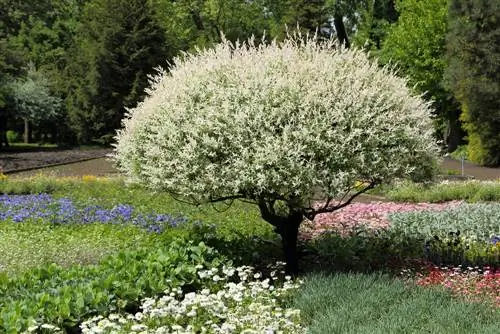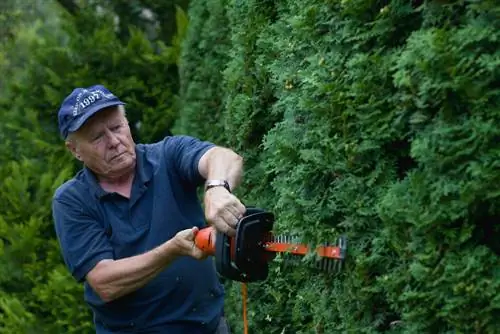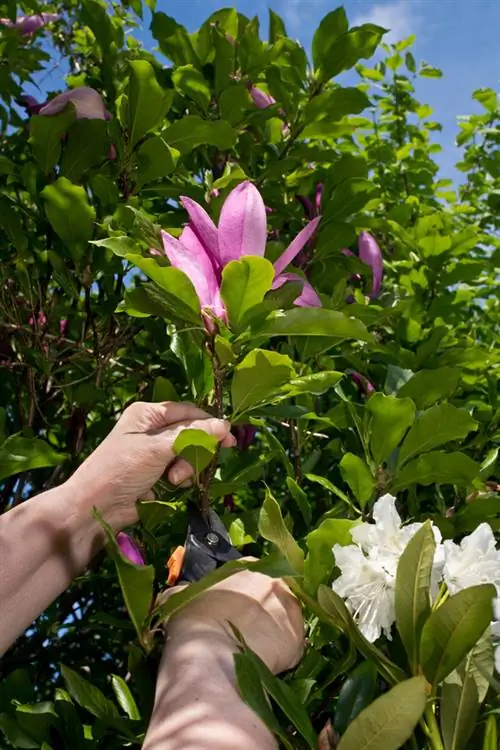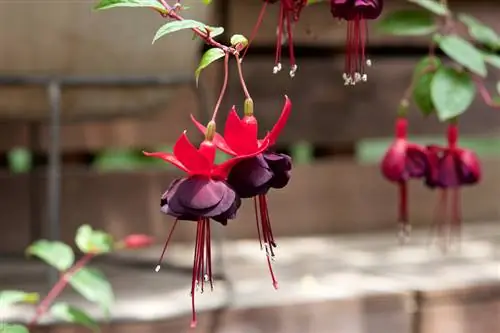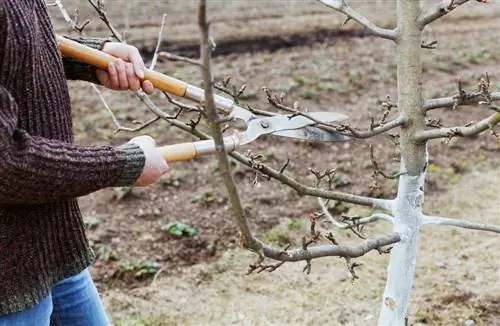- Author admin [email protected].
- Public 2023-12-16 16:46.
- Last modified 2025-06-01 06:02.
A magnolia grows so disciplined that pruning is a rarity. Between the ages of 30 and 50, these flower beauties boast a picturesque crown that is up to 8 meters wide. Interventions with scissors and saws are disruptive. Nevertheless, pruning can make sense. This tutorial explains in practical terms when and how to prune your magnolia without deforming the floral beauty. Important technical terms are explained in a practical and understandable way.

When and why should you prune a magnolia?
Magnolias should only be cut back if targeted pruning is necessary for young plants or to slim down the crown of older trees. The best time to prune is in late summer or spring, depending on the type of pruning and plant development.
Why can a cut make sense? - two occasions are in focus
Magnolias have an aversion to all kinds of pruning measures. Using scissors can neither improve their flowering nor vitalize their growth. On the contrary, regular pruning usually results in a deformed habitus. The digression below explains why this is the case.
When magnolia gardeners pick up scissors, there is a solid reason. First and foremost, the high purchase prices for early-grown young magnolias are the decisive motive. Savings hunters prefer to purchase an inexpensive young plant with a height of 60 cm in order to direct it into an opulent flowering bush with targeted pruning.
Proud owners of a majestic magnolia always resort to the saw when the sprawling crown has become a serious obstacle. In the course of pruning, the expansive magnolia tree is prescribed a slimming treatment. This requires a fair amount of sensitivity and the instructions in this tutorial for a topiary.
Excursus
Growing Magnolias
Magnolias thrive as so-called valuable flowering shrubs, characterized by acronous growth. Specifically, this means that new shoots arise primarily from terminal buds and the upper side buds of the branches. As a result, a harmonious, flower-rich crown structure develops that cannot be optimized by pruning. In contrast, simple flowering shrubs, such as forsythia, are characterized by basitone to mesonte growth. Here the branches sprout from the base and the middle shoot segments. As a result, simple ornamental trees age within a few years, which makes regular thinning or radical rejuvenation every 3 years unavoidable.
When is the best time to prune?
The right time to cut magnolias needs to be chosen carefully. The ornamental trees lay their buds for the next flowering period in the fall of the previous year. You can admire the voluminous flowers on the shoot ends throughout the winter. Furthermore, an intense sap pressure builds up from the rootstock. After a cut in the middle of the growing season, a strong flow of sap can be observed at the cut wounds. This process not only affects the appearance. If a magnolia bleeds, valuable reserve substances are lost that are later needed for the growth of flowers and leaves. These dates have proven to work well in practice:
- Topiary pruning to slim the crown: in late summer, in time before the buds are planted
- Secondary cut: in spring, after the end of the frost period
As long as the shoots of a young magnolia to be cut are as thick as a pencil, there will be no significant sap flow. The best time for pruning is immediately after planting in spring. Ideally, no more delayed ground frosts should be expected.
Instructions for the built-up cut
As premium trees, 60 centimeter small young magnolias cost an impressive 45 to 50 euros when purchased. Larger specimens with a height of 100 to 150 centimeters cost a whopping 100 euros and more. Who wants to max out their gardening budget on a single plant? Price-conscious home gardeners make do with a mini-sized magnolia and subject it to pruning. This is how it works:
- Cut back main shoots by a maximum of half
- Short existing side branches by a third
- Make each cut on bud
The construction cut acts as the initial spark for a naturally beautiful crown structure over a short trunk. No further cutting measures are required. On the contrary, interventions in the growth of a magnolia regularly result in bitter disappointment for the gardener.
Tip
Magnolias shed wilted petals independently. If this process is too slow for you, simply clean out the faded flowers. Place the scissors below the first or second pair of leaves below the withered flower. There is no need to fear an intensive flow of sap at this point.
Slimming a protruding crown - this is how to achieve a topiary
The extensive growth of a magnolia crown is often underestimated. If you constantly collide with the sprawling branches on garden paths, this shortcoming will reduce your enjoyment of the majestic magnificent tree. Careful downsizing using the pruning saw is the best solution to the problem. Use this cut to shape the magnolia:
- Excessively long, old branches should preferably be removed completely, as shown in the figure below
- Cut to Astring when cutting out
- Alternatively, derive an unfavorably positioned old branch from a younger side branch
Please plan each individual cut carefully. To achieve the goal of a narrower crown without gaps, first focus on the branches that protrude furthest from the shape. After each cut, take a few steps back to examine the result from a distance and choose the next starting point for the saw.
Tip
Please cut off a thick branch with a diameter of more than 4 centimeters in 3 stages. First, place the saw at a distance of 15 to 20 centimeters from the bottom and cut a little way into the branch. Then move the saw 5 to 10 centimeters towards the trunk and saw until the branch breaks. In the last step, cut the remaining stump on Astring and smooth the wound with a disinfected knife.
Cutting technique for beginners - explanation of terms
When it comes to the pruning and topiary of valuable ornamental trees, home gardeners are confronted with technical terms that are not common in everyday practice. There are terms used to describe a skillful cutting technique on magnolias, such as “cutting on a bud”, “cutting on a string” and “deriving”. Read below about the procedure behind each technical term:
Cutting on bud
We always talk about cutting on bud when a shoot is shortened. To ensure that the subsequent growth of fresh branches runs smoothly, the scissors must not be used indiscriminately. The cut should be made at a short distance from a shoot bud. If you cut too close, the bud will dry out and your hopes of a fresh shoot will be gone. Long stubs, on the other hand, are dangerous sources of infection because the rotting wood attracts fungal pathogens and pests. The image below shows what to pay attention to when cutting buds.
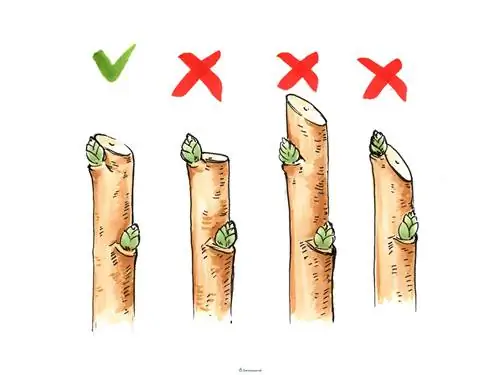
Cut the young magnolia shoot a few millimeters above a shoot bud that faces outwards. Holding the scissors slightly at an angle allows rainwater to drain away more quickly.
Cutting on Astring
In the transition from the branch to the trunk or leading shoot there is a bead-shaped thickening, the branch ring. This contains tissue capable of dividing (cambium), which covers a cut wound from the outside in with fresh bark. This dividing tissue must not be injured. Place the saw just in front of the branch ring and saw away from the trunk at a slight angle. Finally, smooth the cut with a knife. The sketch below shows how to do it correctly.
Deduce
The technical term derivation describes the cutting back of an outdated or unfavorably positioned branch to a side branch underneath. This cutting technique is used if you do not completely cut out an old magnolia branch. Place the scissors or saw after the branching, as shown in the illustration below. Make the cut itself diagonally backwards. Now all the sap pressure flows into the younger side shoots and promotes growth. The dreaded crown gap cannot occur during derivation.
Facts about cutting in brief - cutting profile
The growth of magnolias is characterized by individual characteristics that influence expert pruning care. The following profile briefly summarizes all relevant factors:
- Magnolia genus with 300 species and numerous garden varieties
- Origin: primarily East Asia
- Growth: summer-green flowering shrub or short-stemmed tree with a spreading crown
- Special feature: strong sap flow in spring and summer
- Height: 300 to 900 cm
- Width: 250 to 800 cm
- Flowering time: April to May before the leaves emerge
- Planting the buds: in the fall of the previous year
- Special feature: acrotonic growth - flower buds mostly terminal
- Cutting tolerance: limited
- Winter hardiness: good, with risk of late frost for inflorescences
- Toxic: slightly toxic
By far the most common magnolia in European gardens and parks is the tulip magnolia (Magnolia × soulangeana) with numerous, breathtakingly beautiful varieties. For small gardens and front gardens, tree nurseries have more delicate star magnolias (Magnolia stellata) available, which remain at a height of 300 centimeters and can reach a width of 200 centimeters.
Frequently asked questions
Several large cuts were created when cutting an old magnolia. Is a wound closure agent advisable or not?
Wound treatment on trees has proven to be a fallacy. Field tests have shown that sealing cuts does more harm than good to a tree. The valuable dividing tissue must not be prevented by tree wax from successively overflowing the wound. All you need to do is smooth the edges of cuts with a sharp knife and trust the healing powers of your magnolia. The only exception are large wounds that occur before winter. In this case, apply a thin layer of tree wax to the smoothed edges of the wound to protect the dividing tissue from frost damage.
Can I propagate my magnolia with cuttings?
The most promising form of propagation is with the help of planters, provided you are cultivating a magnolia as a shrub. Breeding with cuttings is explosive in two respects. On the one hand, you will harm your magnolia if you take top cuttings in the middle of the season. Furthermore, vegetative propagation from cuttings is associated with a high failure rate. Sowing seeds requires a long process of patience, up to 6 months for germination. Hybrids thrive that often bear no resemblance to the mother plant. The first flowering period can be expected after 10 years at the earliest. For these reasons, tree nurseries offer refined magnolias whose flowers develop after just 2 to 3 years.

Tip
Some of the most beautiful magnolias are grafted onto a robust wild base. If vertical shoots sprout out of the blue from the root disk, they are strong-growing water shooters because the wild substrate is pushing through. Cut off these wild shoots as soon as possible because they tend to overgrow the noble magnolia.


